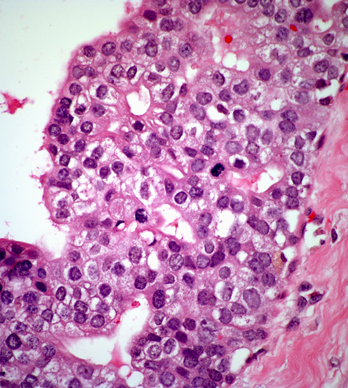Pathologists Often Disagree on Breast Biopsy Findings
While pathologists usually agree on healthy and malignant breast tissue from biopsy slides, there is less agreement on samples that fall somewhere in the middle.
High magnification of DCIS showing cellular atypia and mitotic activity.

While pathologists are usually able to agree whether breast tissue is healthy or malignant from biopsy slides, there is far less agreement on tissue samples that fall somewhere in the middle, according to a new study published in JAMA.
The study, by Joann G. Elmore, MD, MPH, of the University of Washington, Seattle, and colleagues found that among 115 pathologists in eight states in the United States that reviewed the same 6,900 breast biopsy slides, the rate of overall agreement-or the concordance rate-was 75.3%. The highest level of agreement was for invasive breast cancer and the lowest was for ductal carcinoma in situ (DCIS) and atypical hyperplasia.
Women with atypia or DCIS have a higher risk of subsequently being diagnosed with invasive carcinoma and may require additional surveillance or even treatment to reduce their risk of progression. Breast cancer experts still disagree on whether DCIS is, in fact, cancer.
While breast biopsies remain the gold standard to diagnose breast cancer, these findings underscore the ambiguity that can exist when clinicians interpret biopsies.
“These findings are disconcerting but perhaps not all together surprising,” wrote Nancy E. Davidson, MD, of the University of Pittsburgh Cancer Institute and UPMC Cancer Center, and David L. Rimm, MD, PhD, of the department of pathology at the Yale University School of Medicine, in New Haven, Connecticut, in an accompanying editorial. “Morphologic diagnosis rests on broad acceptance of key criteria, some of which are easily and specifically defined but many of which are very subtle and difficult to describe in words.”
[[{"type":"media","view_mode":"media_crop","fid":"33280","attributes":{"alt":"","class":"media-image","id":"media_crop_4168198598302","media_crop_h":"0","media_crop_image_style":"-1","media_crop_instance":"3506","media_crop_rotate":"0","media_crop_scale_h":"0","media_crop_scale_w":"0","media_crop_w":"0","media_crop_x":"0","media_crop_y":"0","style":"height: 164px; width: 164px;","title":" ","typeof":"foaf:Image"}}]]
Slides of breast biopsies
Of the slides of benign tissue, 87% were concordant and 13% of the samples were overinterpreted. The concordance rate was 96% for samples containing invasive carcinoma with a 4% underinterpretation rate.
Of the atypical hyperplasia samples, the concordance rate among pathologists was 48%; 17% of the samples were overinterpreted and 35% of the samples were underinterpreted. The concordance rate was 84% for DCIS; 3% of the samples were overinterpreted and 13% were underinterpreted.
The study found statistically significant differences in diagnosis disagreement in biopsies of women with higher breast density (P < .001); and in pathologists who analyzed a relatively low volume of cases per week (P < .001), worked in smaller practices (P = .034), or worked in a non-academic setting (P = .007).
[[{"type":"media","view_mode":"media_crop","fid":"33281","attributes":{"alt":"","class":"media-image","id":"media_crop_7692911154062","media_crop_h":"0","media_crop_image_style":"-1","media_crop_instance":"3507","media_crop_rotate":"0","media_crop_scale_h":"0","media_crop_scale_w":"0","media_crop_w":"0","media_crop_x":"0","media_crop_y":"0","style":"height: 164px; width: 164px;","title":" ","typeof":"foaf:Image"}}]]
Slides of metastatic disease
About 1.6 million breast biopsies are conducted every year in the United States and about one-quarter of these are diagnosed as invasive disease. The majority, however, fall along the spectrum between benign and invasive disease. According to the study authors, the accuracy of pathologists’ diagnoses is important and not adequately studied.
In their editorial, Davidson and Rimm wrote that these results should be a call to action for pathologists and breast cancer researchers. Particularly concerning, they noted, is that 4% of pathologists missed diagnoses of invasive breast cancer.
Davidson and Rimm recommended that second opinions should be sought in ambiguous biopsy cases.
While there are some limitations to the study, including the high number of particularly ambiguous and difficult cases to diagnose, the editorial authors described the current study as “well-designed and conducted.”
According to Davidson and Rimm, an undesirable short-term outcome of the current work will be an uptick in the anxiety among women undergoing a breast biopsy. “However,” they wrote, “this study confirms that the majority of diagnoses, especially at either end of the spectrum from benign to invasive cancer, are readily and accurately made by practicing pathologists.”
Newsletter
Stay up to date on recent advances in the multidisciplinary approach to cancer.